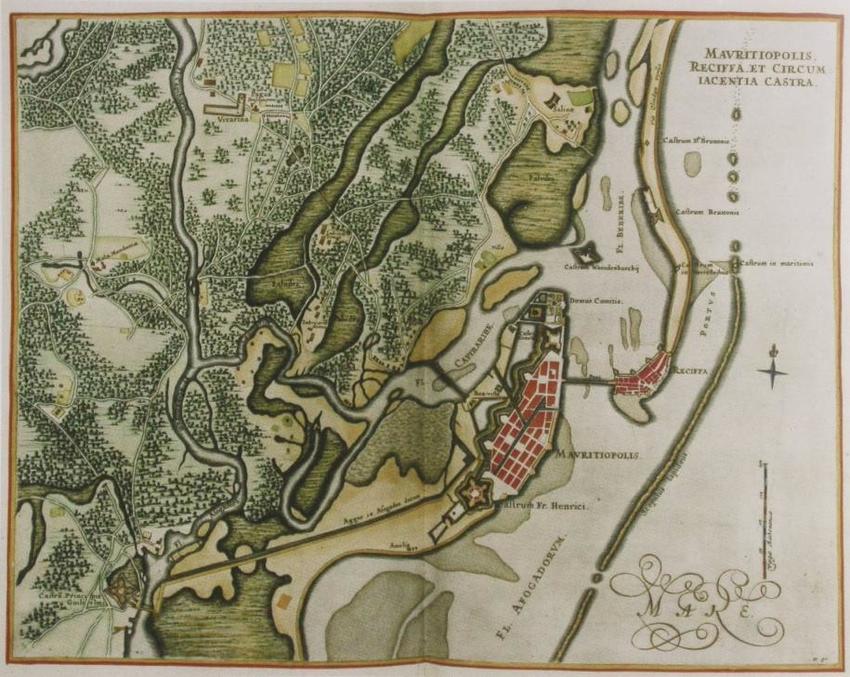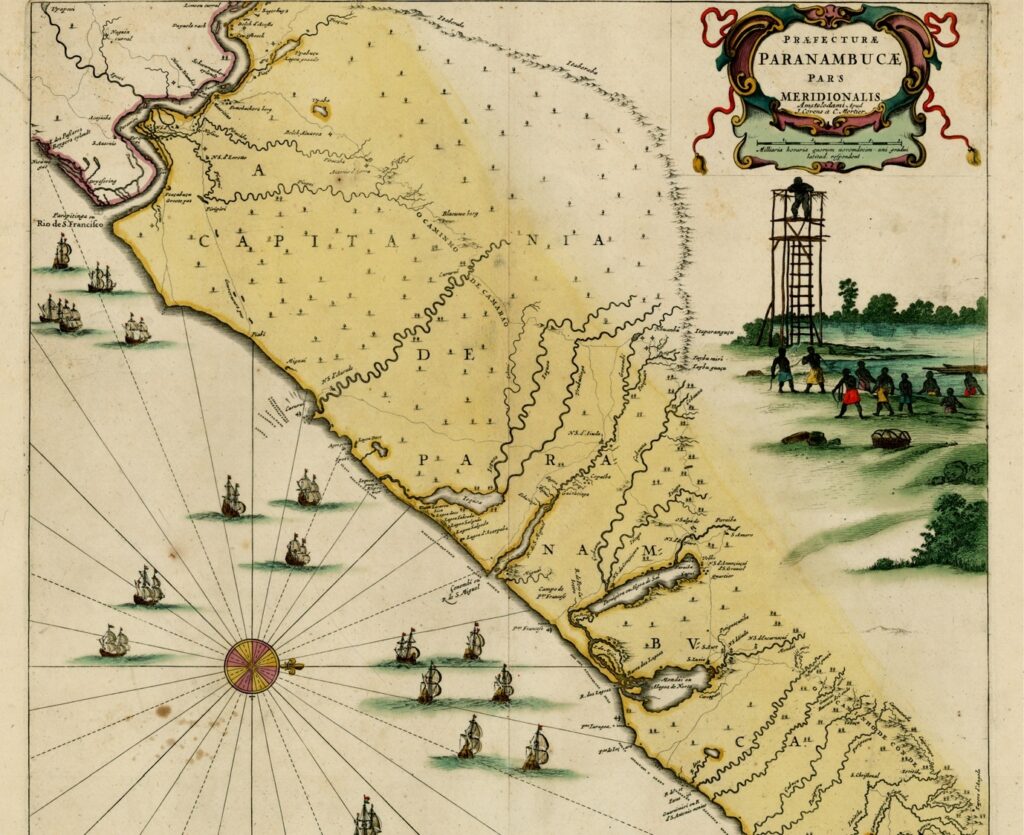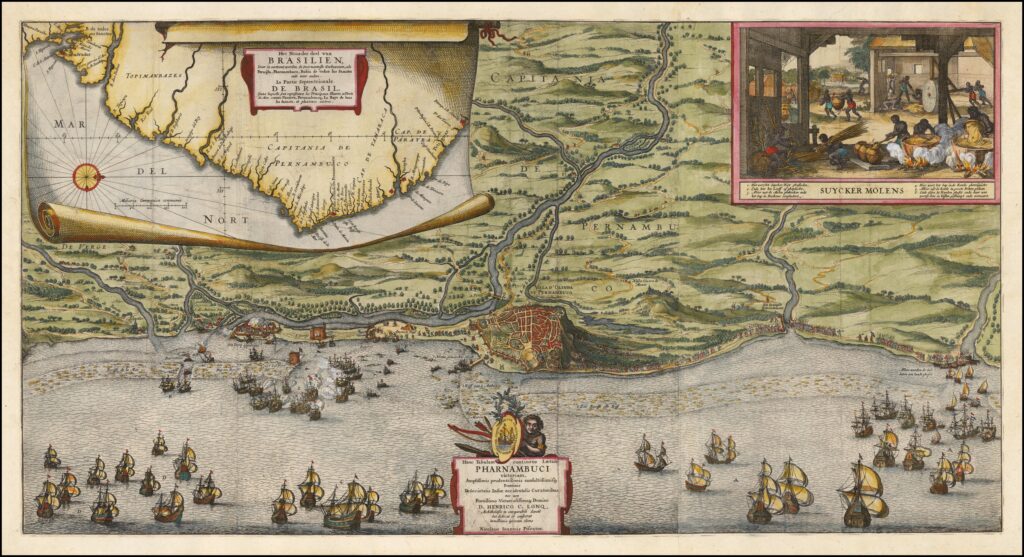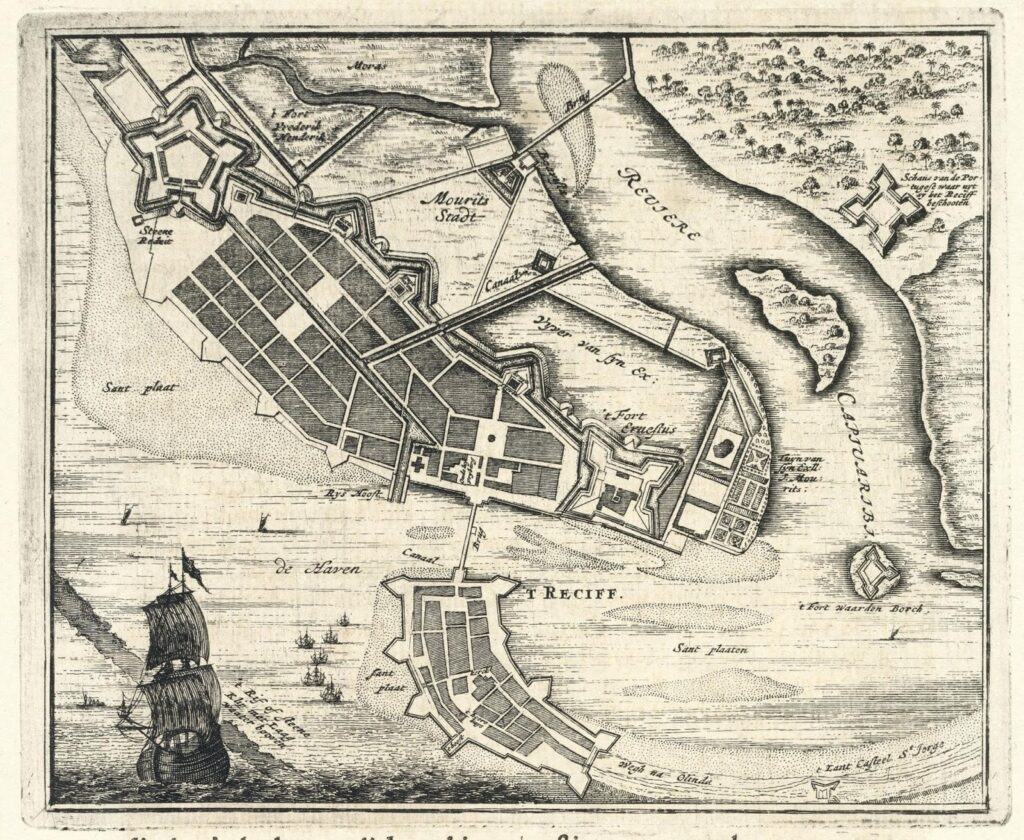Pernambuco and its capital Recife have a rich history, marked by important events that have shaped not only the region, but also Brazil.
Pernambuco and its capital, Recife, have a turbulent history.

The history of Recife began in 1537: the King of Portugal divided the large colony into strips of land.
The lands, called hereditary captaincies, were given to wealthy entrepreneurs to prosper in the name of the crown.
But in dividing the land, the King also divided the huge investment needed to make such a vast country manageable and, above all, profitable.
Few hereditary captainships lasted, but Duarte Coelho managed to make a success of Pernambuco with Olinda as his capital.
The most important cash crop in Pernambuco was sugar cane.
In 1630, the Dutch conquered the area, marking a major event in the history of northeastern Brazil.

They ruled over a vast area stretching roughly from São Luís do Maranhão to Salvador in Bahia. Under the inspiring reign of John Maurice of Nassau, Recife’s urban planning was realised by designing a street plan and building bridges, bringing in prominent architects.
When John Maurice had to leave Recife, there was turmoil: a small army of Portuguese soldiers and local rebels took over and drove the Dutch out of northeastern Brazil.
The history of Pernambuco and Recife is marked by conflicts between indigenous peoples and the Portuguese, Dutch rule and even an attempt at independence.
Discover the history of Pernambuco and Recife, one of the oldest states in Brazil.

História de Recife PE
Main historical landmarks of Pernambuco and Recife
The history of Pernambuco and Recife is one of conflict.
- Indians in Pernambuco
- Colonisation of Pernambuco
- Territory of the Captaincy of Pernambuco
- Sack of Recife in 1595
- Dutch occupation (1630-1645)
- Mascato War
- Confederation of the Cariris
- Pernambuco Revolution – 1817
- Confederation of Ecuador – 1824
- Prairie Revolution – 1848
- Development of the sugar industry
1 The indigenous peoples of Pernambuco
The territory that is now the state of Pernambuco was populated by various indigenous tribes, such as the Caetés, Cariris and Tabajaras, among others.
Each had its own language and customs, and were often enemies. This was important to the Europeans as they made alliances with different indigenous peoples in order to conquer territory.
2. Colonisation of Pernambuco
Through the system of hereditary captaincies, Duarte Coelho took possession of the captaincy of Pernambuco, initially called the New Lusitania Captaincy.
The town of Olinda was founded in 1535 and became a village in 1537.
Olinda was founded in 1535 by the grantee Duarte Coelho, making it one of the first cities in Brazil. Initially, it was the administrative and economic centre of the Captaincy of Pernambuco.
Olinda became an important cultural and religious centre, with a legacy that is still visible today in its colonial architectural ensemble, which has been declared a UNESCO World Heritage Site.
The city of Recife was also founded in 1537.
Not all hereditary captaincies were successful, but thanks to the cultivation of sugar cane, the captaincy of Pernambuco prospered.
At first, the Portuguese used native slaves to work the sugar cane plantations.
However, due to the lucrative slave trade with the Portuguese colonies in Africa, plantation owners began to use black slaves on the plantations.
3. Territory of the Captaincy of Pernambuco
The Captaincy of Pernambuco covered a much larger area than today. It included what we now call the states of Paraíba, Rio Grande do Norte, Alagoas, Ceará and part of Bahia.

4. Sack of Recife in 1595
By the end of the 16th century, the captaincy of Pernambuco had become one of the richest in the colony. This attracted the attention of the English, Dutch and French, who organised expeditions to take over the capital, Olinda.
It’s important to remember that at this time Portugal was united with Spain in what was known as the Iberian Union.
Spain, in turn, was at war with England and Holland.
Olinda had to be invaded, as did Seville. The English, allied with the Dutch, conquered Recife in 1595, taking several valuable products such as sugar, timber and cotton.
The Sack of Recife, also known as James Lancaster’s Expedition of 1595 and Lancaster’s Pernambucan Expedition, refers to an English military expedition that took place in April 1595, during the Anglo-Spanish War, whose objective was to sack the port of Recife, near Olinda, in Pernambuco, colonial Brazil, then part of the Iberian Union.
Led by the English Admiral James Lancaster, it was the only British privateering expedition with Brazil as its main target and represented the richest booty in the history of Elizabethan privateering.
The expedition sailed across the Atlantic and captured numerous ships before reaching its destination, Pernambuco, the richest captaincy in colonial Brazil. Lancaster captured the port of Recife and remained there for nearly a month, defeating a series of Portuguese counterattacks before setting sail.
The amount of sugar, brazilwood, cotton and high-value goods looted was so great that he was forced to charter Dutch and French ships to take the goods to England, making the expedition a complete military and financial success.
From then on, the captaincy organised two companies for the defence of Recife and Olinda.
5. Dutch occupation (1630-1645)
The Dutch invasion began in Bahia in 1624 and they were driven from the capital a year later by the action of a Portuguese-Spanish armada.

However, they would return to take a piece of the sugar trade by invading Recife and Olinda in 1630.
Recife was officially promoted to city status during the Dutch occupation of Brazil, when the West India Company invaded Pernambuco in 1630.
Under the command of Maurício de Nassau (1637-1644), Recife flourished, with the construction of bridges, canals and the introduction of urban and cultural advances. Nassau transformed Recife into a cosmopolitan centre, promoting religious tolerance and the development of the arts and sciences.
End of the occupation: The Pernambuco uprising (1645-1654) led to the expulsion of the Dutch in 1654, marking an important moment of local resistance.
Despite fierce fighting – Olinda was burnt down – the Dutch remained in these lands until the outbreak of the Pernambuco Uprising in 1645.

6. War of the Mascates
The War of the Mascates took place between 1710 and 1711 between the plantation owners concentrated in Olinda and the Portuguese merchants living in Recife.
The Mascates War was a conflict between the Portuguese merchants of Recife (the “Mascates”) and the mill owners of Olinda, who resisted the growing economic and political influence of Recife.
The victory of the mascates consolidated Recife as the most important city in the region, culminating in its elevation to city status in 1710, separating it administratively from Olinda.
Many historians point to this war as the first nativist uprising in Brazil.
The conflict pitted the white elite born in Brazil against the Portuguese who had recently arrived from the metropolis.
7. Confederation of the Cariris
The Confederation of the Cariris, or War of the Barbarians, was a series of battles that took place between 1683 and 1713.
After the expulsion of the Dutch, the Portuguese colonists continued to expand into the north-eastern interior. Their aim was to increase sugar and cotton production, as well as cattle grazing.
But some indigenous tribes, such as the Cariris, Crateús and Cariús, banded together and began attacking the farms.
To defeat them, the northeastern landowners had to call in bandeirantes from São Paulo to fight them. The Confederation of the Cariris did not end until 1713, when the last pockets of resistance in Ceará were wiped out.
8. Pernambuco Revolution – 1817
In the first half of the 19th century, several territories in the Americas rebelled against European rule.
This revolution was one of the first attempts at independence in Brazil, inspired by the ideals of the Enlightenment and the examples of other revolutions around the world.
Inspired by the ideas of the Enlightenment and the independence of the United States, a group of rebels planned to emancipate what was then the province of Pernambuco.
Initially victorious, the rebels set up a provisional republican government and established freedom of religion and the press.
The uprising lasted just over two months and was violently suppressed by Portuguese troops. However, the Pernambuco Revolution is remembered as a symbol of the struggle for freedom and independence.
It was harshly suppressed by troops sent by Dom João VI. As punishment, four participants were executed and the territory of Alagoas became an independent province.
9. Confederation of Ecuador – 1824
The Confederation of Ecuador was a separatist and republican uprising that took place in Pernambuco in 1824. It must be understood in the context of the First Regency, when Dom Pedro I was in power.
A separatist movement that arose as a reaction to the centralisation of power by Dom Pedro I, shortly after Brazil’s independence.
Pernambuco was the epicentre of this revolt, which sought to create an independent republic in the north-east. The movement was defeated, but it highlighted the tensions between the central government and the provinces.
The Confederation of Ecuador was harshly suppressed by imperial troops who attacked Recife and some of its leaders, such as Frei Caneca, were executed.
10. Praieira Revolution – 1848
The Praieira Revolt was a liberal and republican movement that took place in Pernambuco during the imperial period, influenced by the European revolutions of 1848.
Despite its defeat, the Praieira Uprising is considered an important struggle for civil rights and democracy in Brazil.
The protests began at the headquarters of the Diário Novo newspaper on Rua da Praia, and its members were known as ‘praieiros’.
Fighting began in Recife, but soon spread to the Zona da Mata in Pernambuco.
The rebellion would only end two years later with imperial intervention, and several of its leaders were amnestied.
11. Development of the sugar industry
16th to 19th centuries: Pernambuco, especially the Recife and Olinda regions, was one of the largest centres of sugar production during the colonial period. The wealth generated by sugar cane boosted the region’s development, albeit at the cost of slave labour.
Legacy: The legacy of the sugar economy is still present in Pernambuco’s culture and landscape, with historic sugar mills still visible.
See Pernambuco’s Oldest Churches and the First Church in Brazil
History of Pernambuco and Recife
Publicações Relacionadas
Cais do Sertão Museum: Discover Sertanejo Culture
Museu do Homem do Nordeste: A Cultural Journey
History of the Church of Our Lady of the Rosary of the Black Men
History of the Basilica of Our Lady of Mount Carmel in Recife
Sacred Recife and Religious Tourism in Recife, Pernambuco
Basilica of Our Lady of Penha: A Historical Overview
Church of Nossa Senhora da Boa Viagem History
History and architecture of the Palácio do Campo das Princesas in Recife
Igarassu: Discover the historic city of Pernambuco
Main Tourist Attractions in Recife You Must Visit
History and Curiosities of the Kahal Zur Israel Synagogue
Exploring the Charm of Recife: A Historical Journey
Recife of the Dutch and Dutch Invasion in Brazil
Church of Santa Teresa D'Ávila da Terceira Ordem do Carmo History
This post is also on:
![]() Português
Português ![]() English
English ![]() Deutsch
Deutsch ![]() Español
Español ![]() Français
Français



















